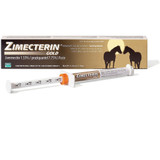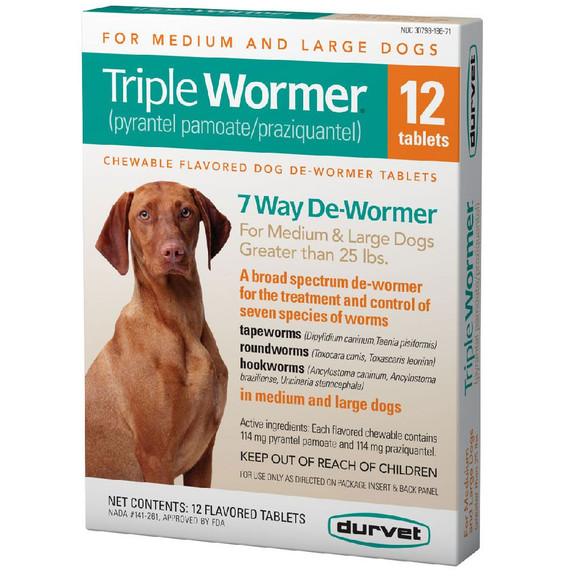-
Description
Description
<b style="color:#7f6a39">Zimecterin Gold</b> is the first and only de-wormer approved by the FDA to eliminate 61 species and stages of equine parasites. Combines Ivermectin and Praziquantel to offer the most comprehensive equine parasite control. Offers a spectrum of control so complete it even protects against tapeworms.
<br /><br />
<b style="color:#7f6a39">Active Ingredients:</b> (Ivermectin 1.55% / praziquantel 7.75%) Paste<br>
<br />
<b style="color:#7f6a39">INDICATIONS</b>
<br><br>
<b style="color:#7f6a39">ZIMECTERIN® GOLD</b> (ivermectin/praziquantel) Paste provides effective treatment and control of the following parasites in horses.
<br>
<li style="color:#7f6a39" type="circle"><b>Tapeworms</b><span style="color:#000000"><font size="-1"> - Anoplocephala perfoliata,</font></span></li><br />
<li style="color:#7f6a39" type="circle"><b>Large Strongyles (adults) </b><span style="color:#000000"><font size="-1"> - Strongylus vulgaris (also early forms in blood vessels), S. edentatus (also tissue stages), S. equinus, Triodontophorus spp. including T. brevicauda and T. serratus and Craterostomum acuticaudatum</font></span></li><br />
<li style="color:#7f6a39" type="circle"><b>Small Strongyles</b><span style="color:#000000"><font size="-1"> - (adults, including those resistant to some benzimidazole class compounds) – Coronocyclus spp. including C. coronatus, C. labiatus and C. labratus, Cyathostomum spp. including C. catinatum and C. pateratum, Cylicocyclus spp. including C. insigne, C. leptostomum, C. nassatus, and C. brevicapsulatus, Cylicodontophorus spp., Cylicostephanus spp., including C. calicatus, C. goldi, C. longibursatus and C. minutus, and Petrovinema poculatum</font></span></li><br />
<li style="color:#7f6a39" type="circle"><b>Small Strongyles</b><span style="color:#000000"><font size="-1"> - Fourth-stage larvae</font></span></li><br />
<li style="color:#7f6a39" type="circle"><b>Pinworms</b><span style="color:#000000"><font size="-1"> - (adults and fourth-stage larvae) – Oxyuris equi</font></span></li><br />
<li style="color:#7f6a39" type="circle"><b>Ascarids</b><span style="color:#000000"><font size="-1"> - (adults and third- and fourth-stage larvae) – Parascaris equorum</font></span></li><br />
<li style="color:#7f6a39" type="circle"><b>Hairworms (adults)</b><span style="color:#000000"><font size="-1"> - Trichostrongylus axei</font></span></li><br />
<li style="color:#7f6a39" type="circle"><b>Large-mouth </b><span style="color:#000000"><font size="-1"> - arnfieldi</font></span></li><br />
<li style="color:#7f6a39" type="circle"><b>Intestinal Threadworms (adults)</b><span style="color:#000000"><font size="-1"> - Strongyloides westeri</font></span></li><br />
<li style="color:#7f6a39" type="circle"><b>Summer Sores</b><span style="color:#000000"><font size="-1"> - caused by Habronema and Draschia spp. cutaneous third-stage larvae; Dermatitis caused by neck threadworm microfilariae, Onchocerca sp.</font></span></li>
<b style="color:#7f6a39">Zimecterin Gold</b> is the first and only de-wormer approved by the FDA to eliminate 61 species and stages of equine parasites. Combines Ivermectin and Praziquantel to offer the most comprehensive equine parasite control. Offers a spectrum of control so complete it even protects against tapeworms.
<br /><br />
<b style="color:#7f6a39">Active Ingredients:</b> (Ivermectin 1.55% / praziquantel 7.75%) Paste<br>
<br />
<b style="color:#7f6a39">INDICATIONS</b>
<br><br>
<b style="color:#7f6a39">ZIMECTERIN® GOLD</b> (ivermectin/praziquantel) Paste provides effective treatment and control of the following parasites in horses.
<br>
<li style="color:#7f6a39" type="circle"><b>Tapeworms</b><span style="color:#000000"><font size="-1"> - Anoplocephala perfoliata,</font></span></li><br />
<li style="color:#7f6a39" type="circle"><b>Large Strongyles (adults) </b><span style="color:#000000"><font size="-1"> - Strongylus vulgaris (also early forms in blood vessels), S. edentatus (also tissue stages), S. equinus, Triodontophorus spp. including T. brevicauda and T. serratus and Craterostomum acuticaudatum</font></span></li><br />
<li style="color:#7f6a39" type="circle"><b>Small Strongyles</b><span style="color:#000000"><font size="-1"> - (adults, including those resistant to some benzimidazole class compounds) – Coronocyclus spp. including C. coronatus, C. labiatus and C. labratus, Cyathostomum spp. including C. catinatum and C. pateratum, Cylicocyclus spp. including C. insigne, C. leptostomum, C. nassatus, and C. brevicapsulatus, Cylicodontophorus spp., Cylicostephanus spp., including C. calicatus, C. goldi, C. longibursatus and C. minutus, and Petrovinema poculatum</font></span></li><br />
<li style="color:#7f6a39" type="circle"><b>Small Strongyles</b><span style="color:#000000"><font size="-1"> - Fourth-stage larvae</font></span></li><br />
<li style="color:#7f6a39" type="circle"><b>Pinworms</b><span style="color:#000000"><font size="-1"> - (adults and fourth-stage larvae) – Oxyuris equi</font></span></li><br />
<li style="color:#7f6a39" type="circle"><b>Ascarids</b><span style="color:#000000"><font size="-1"> - (adults and third- and fourth-stage larvae) – Parascaris equorum</font></span></li><br />
<li style="color:#7f6a39" type="circle"><b>Hairworms (adults)</b><span style="color:#000000"><font size="-1"> - Trichostrongylus axei</font></span></li><br />
<li style="color:#7f6a39" type="circle"><b>Large-mouth </b><span style="color:#000000"><font size="-1"> - arnfieldi</font></span></li><br />
<li style="color:#7f6a39" type="circle"><b>Intestinal Threadworms (adults)</b><span style="color:#000000"><font size="-1"> - Strongyloides westeri</font></span></li><br />
<li style="color:#7f6a39" type="circle"><b>Summer Sores</b><span style="color:#000000"><font size="-1"> - caused by Habronema and Draschia spp. cutaneous third-stage larvae; Dermatitis caused by neck threadworm microfilariae, Onchocerca sp.</font></span></li>











